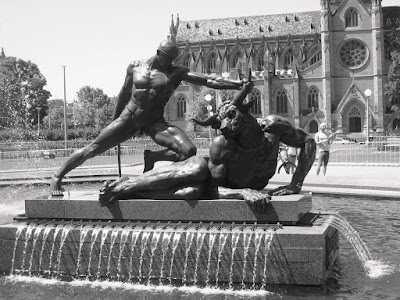
I reposted the above picture in black and white showing Apollo lording over a centaur.
"In art Apollo is at most times depicted as a handsome young man, clean shaven and carrying either a lyre, or his bow and arrows. There are many sculptures of Apollo and one of the most famous is the central figure from the west pediment of the Temple of Zeus, at Olympia, showing Apollo declaring victory in favor of the Lapiths in their struggle against the Centaurs."
"The son of Zeus and Leto, and the twin brother of Artemis. Apollo was the god of music (principally the lyre, and he directed the choir of the Muses) and also of prophecy, colonization, medicine, archery (but not for war or hunting), poetry, dance, intellectual inquiry and the carer of herds and flocks. He was also a god of light, known as "Phoebus" (radiant or beaming, and he was sometimes identified with Helios the sun god).
He was also the god of plague and was worshiped as Smintheus (from sminthos, rat) and as Parnopius (from parnops, grasshopper) and was known as the destroyer of rats and locust, and according to Homer's Iliad, Apollo shot arrows of plague into the Greek camp. Apollo being the god of religious healing would give those guilty of murder and other immoral deeds a ritual purification. Sacred to Apollo are the swan (one legend says that Apollo flew on the back of a swan to the land of the Hyperboreans, he would spend the winter months among them), the wolf and the dolphin. His attributes are the bow and arrows, on his head a laurel crown, and the cithara (or lyre) and plectrum. But his most famous attribute is the tripod, the symbol of his prophetic powers."

"Apollo, as with Zeus his father, had many love affairs with goddesses and mortals. Apollo's infatuation for the nymph Daphne, which had been invoked by the young god of love Eros, because Apollo had mocked him, saying his archery skills were pathetic, and Apollo's singing had also irritated him. Daphne was the beautiful daughter of the river god Ladon, and she was constantly pursued by Apollo. To escape from Apollo's insistent behavior, she fled to the mountains, but the persistent Apollo followed her. Annoyed by this, she asked the river god Peneus for help, which he did. As soon as Apollo approached Daphne, he tried to embrace her, but when he stretched out his arms she transformed into a laurel tree. Apollo, distraught by what had happened, made the laurel his sacred tree. Apollo also loved Cyrene, she was another nymph, and she bore Apollo a son: Aristaeus, a demi-god, who became a protector of cattle and fruit trees, and a deity of hunting, husbandry and bee-keeping. He taught men dairy skills and the use of nets and traps in hunting."
Re-reading this article in Pantheon.org gave me a better perspective regarding the symbolisms and the creatures in this Apollo fountain sculptures at Sydney's Hyde Park. Also I've rediscovered certain things about Apollo and other myriad Greek and Roman Gods and Goddesses.





2 comments:
ako din. salamat dito. sinama mo na rin kami.
kaya I lifted some of it verbatim para di na kayo magpunta duon sa kanilang website. Pero marami ring matutunan duon... next time you see a fountain or Green/Roman sculpture siguradong sama sa mythology.
Post a Comment